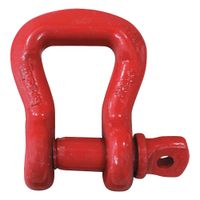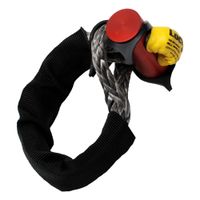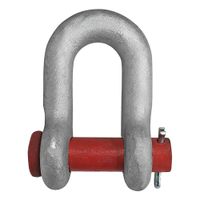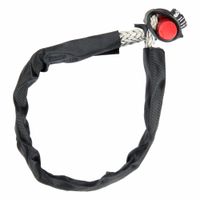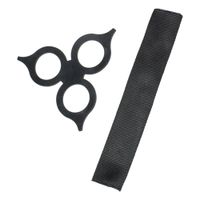Call +(254) 703 030 000 / 751 483 999 / 721 704 777
.....Read More
Frequently Asked Questions
What are the different types of shackles used for lifting and load-securing applications?
There are several types of shackles used for lifting and load-securing applications, each designed for specific purposes:
1. **Anchor Shackles (Bow Shackles):** These have a larger, rounded "O" shape, allowing for multi-directional loading. They are versatile and commonly used in rigging and lifting applications where side loading is a factor.
2. **Chain Shackles (D Shackles):** Featuring a "D" shape, these are designed for straight-line pulls. They are ideal for connecting chains and are used in applications where the load is applied in-line.
3. **Screw Pin Shackles:** These have a threaded pin that can be easily removed and reattached, making them suitable for temporary connections. They are commonly used in applications where the shackle needs to be frequently removed and reattached.
4. **Bolt Type Shackles:** Equipped with a bolt and nut, these provide a more secure connection than screw pin shackles. They are used in long-term or permanent applications where the shackle is not frequently removed.
5. **Round Pin Shackles:** Featuring a round pin secured by a cotter pin, these are used in applications where the load is applied in-line and the shackle is not subject to rotation or twisting.
6. **Wide Body Shackles:** These have a wider body, providing a larger surface area for load distribution. They are used in applications requiring reduced wear on slings and increased load stability.
7. **Synthetic Sling Shackles:** Made from high-strength synthetic materials, these are lightweight and used in applications where metal shackles might damage the load or where weight is a concern.
8. **Safety Pin Shackles:** Designed with an additional safety mechanism to prevent accidental release, these are used in critical applications where safety is paramount.
Each type of shackle is selected based on the specific requirements of the lifting or load-securing task, considering factors such as load direction, frequency of use, and safety requirements.
How do you determine the appropriate shackle size and capacity for a specific load?
1. **Identify Load Requirements**: Determine the weight of the load to be lifted or secured. This is the starting point for selecting the appropriate shackle.
2. **Understand Shackle Types**: Choose between bow shackles (for multi-directional loads) and D shackles (for inline loads). The type affects the load distribution and capacity.
3. **Check Working Load Limit (WLL)**: The shackle's WLL must be equal to or greater than the load weight. The WLL is usually marked on the shackle body.
4. **Consider Safety Factor**: Apply a safety factor, typically 5:1 or 6:1, depending on industry standards and regulations. This means the shackle's breaking load should be 5 to 6 times the WLL.
5. **Measure Pin Diameter**: The pin diameter is crucial for fitting the shackle to the lifting equipment. Ensure it matches the equipment's requirements.
6. **Assess Shackle Size**: The shackle size is determined by the diameter of the bow or body. Larger diameters generally offer higher load capacities.
7. **Material and Environment**: Consider the material (e.g., galvanized steel, stainless steel) based on environmental conditions like corrosion or temperature extremes.
8. **Inspect for Wear and Damage**: Ensure the shackle is free from cracks, deformation, or excessive wear, which can compromise its capacity.
9. **Compliance with Standards**: Ensure the shackle meets relevant standards (e.g., ASME, ASTM, ISO) for quality and safety assurance.
10. **Consult Manufacturer Guidelines**: Refer to the manufacturer's specifications and guidelines for detailed information on shackle capacity and usage.
By following these steps, you can select a shackle that safely and effectively meets the load requirements.
What are the safety guidelines for using shackles in lifting operations?
1. **Inspection**: Before use, inspect shackles for wear, deformation, cracks, and corrosion. Ensure the pin is straight and threads are undamaged.
2. **Load Capacity**: Use shackles within their Working Load Limit (WLL). Never exceed the rated capacity.
3. **Correct Size**: Select the appropriate size and type of shackle for the load and lifting configuration.
4. **Proper Pin Installation**: Ensure the pin is fully engaged and secured. Use the correct type of pin (screw pin, bolt-type, or round pin) for the application.
5. **Alignment**: Align the shackle body with the load. Avoid side loading, which can reduce the shackle's capacity.
6. **Avoid Shock Loading**: Do not subject shackles to sudden or shock loads, as this can cause failure.
7. **Temperature and Environment**: Consider environmental factors such as temperature and chemical exposure, which can affect shackle performance.
8. **Avoid Modifications**: Do not modify shackles. Use them as designed and intended by the manufacturer.
9. **Secure Connections**: Ensure all connections are secure and that the shackle is not twisted or bent during lifting.
10. **Regular Maintenance**: Perform regular maintenance and lubrication to prevent rust and ensure smooth operation.
11. **Training**: Ensure personnel are trained in the proper selection, inspection, and use of shackles.
12. **Storage**: Store shackles in a dry, clean environment to prevent damage and corrosion.
13. **Documentation**: Keep records of inspections and maintenance for accountability and safety compliance.
14. **Follow Manufacturer’s Guidelines**: Always adhere to the manufacturer's instructions and guidelines for safe use.
15. **Emergency Procedures**: Have emergency procedures in place in case of shackle failure during lifting operations.
How do you inspect shackles for wear and damage before use?
1. **Visual Inspection**: Check for any visible signs of wear, deformation, cracks, or corrosion on the shackle body and pin. Look for any signs of elongation or distortion.
2. **Check Pin and Threads**: Ensure the pin is straight and fits properly. Inspect the threads for damage or wear, ensuring they engage fully and smoothly.
3. **Measure Dimensions**: Use calipers to measure the shackle's dimensions, comparing them to the manufacturer's specifications to ensure they are within acceptable limits.
4. **Inspect for Corrosion**: Look for rust or pitting, especially in areas that may have been exposed to harsh environments. Corrosion can weaken the shackle.
5. **Check for Bends or Twists**: Ensure the shackle is not bent or twisted, as this can indicate overloading or misuse.
6. **Examine Load Bearing Areas**: Pay special attention to the areas where the shackle bears the load, such as the bow and pin holes, for signs of excessive wear.
7. **Test Pin Engagement**: Ensure the pin can be fully engaged and secured. For screw pin shackles, the pin should screw in completely and not be cross-threaded.
8. **Look for Manufacturer’s Markings**: Verify that the shackle has clear and legible markings indicating the Working Load Limit (WLL) and manufacturer’s identification.
9. **Check for Modifications**: Ensure the shackle has not been modified or repaired in a way that could affect its integrity.
10. **Consult Manufacturer’s Guidelines**: Follow any specific inspection guidelines provided by the manufacturer for the particular type of shackle.
11. **Record Keeping**: Document the inspection results, noting any defects or issues found, and ensure the shackle is tagged or removed from service if it fails inspection.
What are the advantages of using synthetic shackles over metal shackles?
Synthetic shackles offer several advantages over metal shackles:
1. **Weight**: Synthetic shackles are significantly lighter than metal shackles, making them easier to handle and reducing the overall weight of the load.
2. **Safety**: They are safer to use as they do not have sharp edges and are less likely to cause injury if they snap. The risk of recoil is also minimized compared to metal shackles.
3. **Corrosion Resistance**: Synthetic materials are resistant to rust and corrosion, making them ideal for use in marine environments or where exposure to moisture is a concern.
4. **Flexibility**: Synthetic shackles are more flexible, allowing them to be used in a variety of applications and to conform to different shapes and surfaces.
5. **Non-conductive**: Being non-metallic, synthetic shackles do not conduct electricity, making them safer for use in environments where electrical hazards are present.
6. **Ease of Inspection**: Damage to synthetic shackles is often more visible, allowing for easier inspection and maintenance.
7. **UV and Chemical Resistance**: Many synthetic shackles are treated to resist UV degradation and chemical exposure, extending their lifespan in harsh conditions.
8. **Reduced Noise**: They produce less noise during handling and operation, which can be beneficial in environments where noise reduction is important.
9. **Buoyancy**: Synthetic shackles often float, which can be advantageous in water-based operations.
10. **Versatility**: They can be used in a wide range of temperatures and conditions without compromising performance.
Overall, synthetic shackles provide a safer, more versatile, and often more cost-effective solution compared to traditional metal shackles, especially in specialized applications.
How do you properly maintain and store shackles to ensure longevity?
To properly maintain and store shackles for longevity, follow these steps:
1. **Inspection**: Regularly inspect shackles for wear, deformation, cracks, and corrosion. Check the pin and body for any signs of damage or excessive wear.
2. **Cleaning**: Clean shackles after use, especially if exposed to harsh environments. Use a wire brush or cloth to remove dirt, debris, and any corrosive substances.
3. **Lubrication**: Apply a light coat of lubricant to the pin and threads to prevent rust and ensure smooth operation. Use a lubricant suitable for the environment in which the shackles are used.
4. **Avoid Overloading**: Ensure shackles are used within their rated capacity. Overloading can cause deformation and reduce the lifespan of the shackle.
5. **Proper Use**: Use shackles as intended, ensuring the load is applied correctly. Avoid side loading, which can cause bending or distortion.
6. **Storage**: Store shackles in a dry, clean environment to prevent rust and corrosion. Use storage racks or bins to keep them organized and off the ground.
7. **Environmental Protection**: If shackles are used in corrosive environments, consider using galvanized or stainless steel shackles for better resistance.
8. **Record Keeping**: Maintain a log of inspections and maintenance activities. This helps track the condition and usage history of each shackle.
9. **Training**: Ensure personnel handling shackles are trained in proper use, inspection, and maintenance procedures.
10. **Replacement**: Replace shackles that show signs of wear, damage, or do not pass inspection. Do not attempt to repair or modify shackles.
By following these practices, you can extend the life of your shackles and ensure they remain safe and reliable for lifting operations.
What are the common causes of shackle failure and how can they be prevented?
Common causes of shackle failure include:
1. **Overloading**: Exceeding the shackle's load capacity can lead to deformation or breakage.
- **Prevention**: Always adhere to the manufacturer's load ratings and use the appropriate shackle size for the load.
2. **Improper Use**: Using shackles in applications they are not designed for, such as side loading, can cause failure.
- **Prevention**: Ensure shackles are used as intended, with loads applied in-line with the shackle's body.
3. **Wear and Tear**: Regular use can cause wear, especially on the pin and bow, leading to reduced strength.
- **Prevention**: Conduct regular inspections and replace shackles showing signs of wear.
4. **Corrosion**: Exposure to harsh environments can lead to rust and corrosion, weakening the shackle.
- **Prevention**: Use shackles made from corrosion-resistant materials or apply protective coatings. Regularly clean and maintain shackles.
5. **Fatigue**: Repeated loading and unloading can cause metal fatigue, leading to cracks and eventual failure.
- **Prevention**: Use shackles with a higher fatigue resistance for applications involving frequent load cycles.
6. **Improper Pin Installation**: Incorrectly installed pins can lead to accidental release or failure.
- **Prevention**: Ensure pins are properly seated and secured, using cotter pins or safety bolts if necessary.
7. **Material Defects**: Manufacturing defects can result in weak points in the shackle.
- **Prevention**: Purchase shackles from reputable manufacturers and inspect new shackles before use.
8. **Temperature Extremes**: High or low temperatures can affect the material properties of shackles.
- **Prevention**: Use shackles rated for the specific temperature range of the application.
Regular training and adherence to safety standards are crucial in preventing shackle failure.
